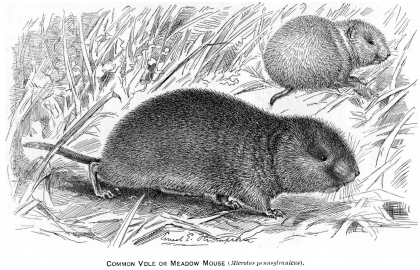
I have spent many hours in the salt marsh over the last few years and over this time I have put together a good tally of fleeting glimpses of scurrying salt marsh rodents. These things are REALLY secretive.
There’s a suite of birds, such as rails, known collectively as “secretive marsh birds”. I have gotten great looks at rails dozens of times, but I haven’t been blessed with even a single lingering look at one of these little rodents.
For these SUPER-secretive marsh rodents, I have been forced to add up these glimpses to form composite sketches of the suspects.
There are really two primary suspects – the meadow vole and the marsh rice rat.
I see the voles when they sprint across gaps of vegetation in the marsh. They are about 6 inches long with dark fur and short tails. I also find their nests in the high marsh. The nests are globe-shaped, about 6 or 8 inches across. They look almost like a bird nest.
The meadow vole has a vast range across most of northern and eastern North America. They live in grasslands, tundra, forest gaps, and marshes. But there are two salt marsh specialist subspecies. One is in Florida (Microtus pennsylvanicus dukecampbelli) and the other is known to occur in North Carolina, Virginia, and Maryland (Microtus pennsylvanicus nigrans). Both subspecies are noticeably darker in color than the average meadow vole.
Darker coloration is a common trait among salt marsh-inhabiting species and subspecies, from birds to mammals.
Our NJ salt marsh voles are also very dark, almost black. These don’t seem to be your average meadow vole. My hunch is that dark salt marsh subspecies from the south is here in New Jersey too.
I am not sure what to do with this hunch. I have discovered that this mammal is also secretive on the internet.
Try googling “Microtus pennsylvanicus nigrans.” The results are very thin. All we can gather is that this subspecies was first discovered in Currituck, NC in 1897 and that it is indeed darker and has a big hind foot, according to a key published in 1900.
Digging deeper, we find that the fellow who described the nigrans subspecies, Samuel N. Rhoads, was a New Jersey-based naturalist who wrote “The Mammals of Pennsylvania and New Jersey” published in 1903.
Who better to decide whether his very-own nigrans resided in his home state?
Rhoads considered the possibility that nigrans might be in NJ, but he concluded that although the salt marsh voles of NJ are larger and grayer than their counterparts in the mountains of PA, they do not approach the nigrans subspecies in their appearance.
I have not seen the other species I mentioned, the marsh rice rat (Oryzomys palustris), as often as the vole. They are large, water-loving rodents adapted to living in marshes. The rice rat is less of a scientific mystery. They are here in New Jersey and most tidal and inland marshes in the eastern U.S. and they run wild all over the internet.
Of local note is that our beloved Witmer Stone documented the presence of the rice rat in New Jersey in 1898 . In Stone’s report it is mentioned that Samuel N. Rhoads looked for the rice rat in Delaware Bay marshes, but came up empty.
If he couldn’t find a rice rat, maybe Rhoads overlooked our black vole too?
It is going to take some more old fashioned mammalogy to figure out the mystery of New Jersey’s black voles. It seems that no one has picked up this “unduly neglected” topic since Rhoads took it up at the turn of the 20th century.
The time is ripe because local naturalists noted with dismay mass drownings of salt marsh rodents in the wake of Hurricane Sandy and they suspected these losses affected wintering raptors such as northern harriers and short-eared owls. See an article about this event here: Sandy leaves pantry bare for N.J.’s coastal raptors.